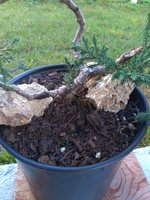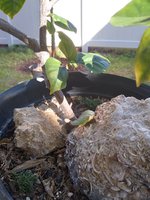Crushed oyster shell is a "standard" media additive for calcium loving plants, especially certain orchids and others that naturally grow on limestone bluffs, or cliffs, alkali fens & other rare habitats. Used for the species of maidenhair ferns that love alkaline soils.
Shells would be a bad choice for acid loving species. Azalea, blueberries, possibly hornbeam and Japanese maple will "fail to thrive" if their media is top dressed with crushed oyster shells.
Whole shells will pose the same potential issues, just at a "lower dose level".
Shells of clams and oysters and most mollusks are largely calcium, with some phosphorous and traces of other minerals. The calcium dominates to a very large extent, the phosphorous is minor, and the rest of the minerals are in small traces. Excess calcium blocks the uptake of nitrogen, phosphorous, and most trace minerals in plants not adapted to a high calcium environment. So if a species is not adapted to a high calcium environment, adding shells can create a nutrient deficiency. But for limestone endemics, and gypsum endemics, there is nothing better for them than crushed oyster shells.
Oyster shell is often used to "sweeten" or raise the alkalinity of acid soils. If one is using peat as your main ingredient in potting soil, in order to adjust the alkalinity to one more favorable for species that prefer a more neutral soil, oyster shell is often added to peat to make a general purpose potting media. A little is a good thing.
If what I remember about Tampa area water, you probably have municipal water that is high in dissolved calcium. You might not want to add shells to your mix if you are raising acid loving trees. But trees like North American native Junipers, buttonwood, Japanese black pine, ginkgo, and a number of Florida natives will actually like the shells, as they like the higher calcium soils.




